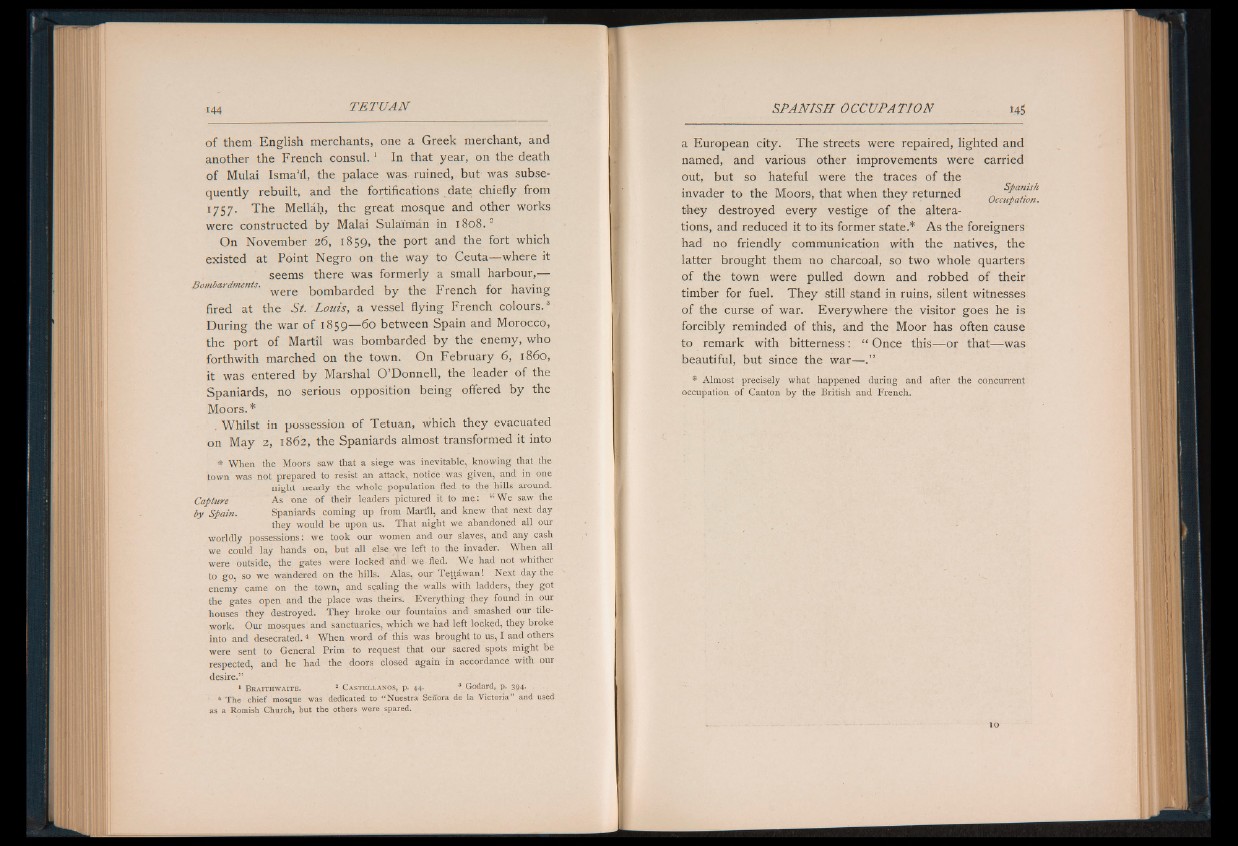
of them English merchants, one a Greek merchant, and
another the French consul.1 In that year, on the death
of Mulai Isma'fl, the palace was ruined, but was subsequently
rebuilt, and the fortifications date chiefly from
1757. The Melláh, the great mosque and other works
were constructed by Malai Sulai'mán in 1808.2
On November 26, 1859, the port and the fort which
existed at Point Negro on the way to Ceuta— where it
seems there was formerly a small harbour,—
Bombardments. wer£ bombarded by the French for having
fired at the St. Louis, a vessel flying French colours.3
During the war of 1859— 60 between Spain and Morocco,
the port of Martil was bombarded by the enemy, who
forthwith marched on the town. On February 6, i860,
it was entered by Marshal O ’Donnell, the leader of the
Spaniards, no serious opposition being offered by the
Moors.*
. Whilst in possession of Tetuan, which they evacuated
on May 2, 1862, the Spaniards almost transformed it into
» When the Moors saw that a siege was inevitable, knowing that the
town was not prepared to resist an attack, notice was given, and in one
night nearly the whole population fled to the hills around.
Capture As one of their leaders pictured it to me: “ We saw the
by Spain. Spaniards coming up from Martil, and knew that next day
they would be upon us. That night we abandoned all our
worldly possessions: we took our women and our slaves, and any cash
we could lay hands on, but all else we left to the invader. When all
were outside, the gates were locked and we fled. We had not whither
to go, so we wandered on the hills. Alas, our Tettáwan! Next day the
enemy came on the town, and scaling the walls with ladders, they got
the gates open and the place was theirs. Everything they found in our
houses they destroyed. They broke our fountains and smashed our tile-
work. Our mosques and sanctuaries, which we had left locked, they broke
into and desecrated. ^ When word of this was brought to us, I and others
were sent to General Prim I to request that our sacred spots might be
respected, and he had the doors closed again in accordance with our
desire.”
1 B e a i t h w a i t e . 1 C a s t e l l a n o s , p. 44. 3 Godard, p. 394.
" The chief mosque was dedicated to “ Nuestra Señora de la Victoria” and uséd
as a Romish Church, but the others were spared.
a European city. The streets were repaired, lighted and
named, and various other improvements were carried
out, but so hateful were the traces of the
invader to the Moors, that when they 7 J returned nO ccuSlpaat"iojsn^*
they destroyed every vestige of the alterations,
and reduced it to its former state.* As the foreigners
had no friendly communication with the natives, the
latter brought them no charcoal, so two whole quarters
of the town were pulled down and robbed of their
timber for fuel. They still stand in ruins, silent witnesses
of the curse of war. Everywhere the visitor goes he is
forcibly reminded of this, and the Moor has often cause
to remark with bitterness: “ Once this— or that— was
beautiful, but since the war— .”
* Almost precisely what happened during and after the concurrent
occupation of Canton by the British and French.